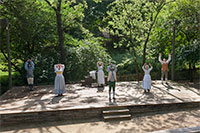Page content
Crossing the Invisible Line
Commitment to portraying the African American experience goes beyond Black History Month
by Nicole Trifone
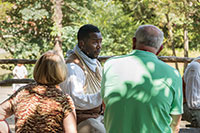
Jeremy Morris, an actor-interpreter who performs in several Historic Area programs, speaks with members of the Journey to Redemption audience after the show.
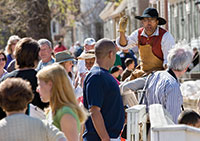
The Colonial Williamsburg Foundation celebrated 30 years of African American interpretive programming in 2009.
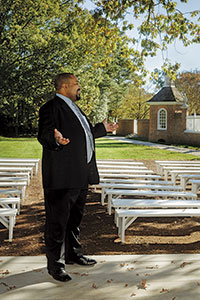
Stephen Seals, an interpretive program development manager, began his career with The Colonial Williamsburg Foundation as an actor-interpreter.
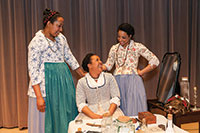
(From left) Hope Wright, Deirdre Jones and Katrinah Lewis wrote and perform in the program A Gathering of Hair, which features three women talking about their lives as they get ready for a wedding.
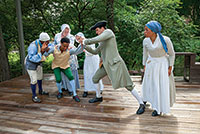
(From left) Jeremy Morris, Jamar Jones, Corinne Dame, Antoinette Brennan, David Catanese and Katrinah Lewis wrote and perform in Journey to Redemption.
Lydia Broadnax and Elizabeth Taliaferro Wythe shared one wish: to have children.
The two women lived in the same house along the Palace Green. They both longed for motherhood. They developed a fondness for the children of other women who also lived in the house.
But one simple fact likely kept the two women from bonding: Wythe and her husband, prominent Williamsburg lawyer George Wythe, owned Lydia.
In the Historic Area program Journey to Redemption, actor-interpreters Katrinah Lewis, who portrays Lydia, and Corinne E. Dame, who plays Elizabeth, are able to imagine how their characters felt about their childlessness and the invisible line their relationship could not cross.
"Perhaps if things were different, we could be a comfort to one another," Lewis and Dame recite in the program, one finishing the other's sentence.
During the half-hour scene, a six-member cast underscores that although slavery was abolished more than 150 years ago, systemic oppression has lived on for generations — and America is still grappling with its effects. While Lydia Broadnax and Elizabeth Wythe might be able to comfort each other in the 21st century, a racial divide remains and continues to stand as an obstacle to open conversation and deep connection.
The program, which began in April 2016, is part of The Colonial Williamsburg Foundation's effort to be part of a national discussion on racial healing. Guests are encouraged to participate, too.
But everyone recognizes that this isn't an easy conversation.
As the cast notes just a few minutes into the scene: "It is the beginning that is most important. That first step. Stepping out into the unknown. Crossing the line. The line of fear. The line of want. Of me and mine. Of you and yours."
A Commitment
While there is a spotlight shining on African American programming throughout Black History Month in February, Colonial Williamsburg's guests encounter the portrayal of free and enslaved blacks in Colonial America every day of the year.
Black History Month features an increased number of theatrical programs that highlight the African American experience, along with the launch of expanded African American interpretation within more building tours and projects for trade shops that contribute to the African American story. However, most of the events that fall under the Black History Month label are offered year-round.
"The overarching goal is to be America's Williamsburg — a place where all Americans can find their story. We're making a commitment to this, particularly on the African American side," said Ted Maris-Wolf, Colonial Williamsburg's vice president of Education, Research and Historical Interpretation. "We want every guest who comes to Colonial Williamsburg today to encounter a variety of African American perspectives, as would have every visitor to 18th-century Williamsburg."
More than 50 years after John D. Rockefeller, Jr. and the Rev. Dr. W.A.R. Goodwin began planning the Restoration of Colonial Williamsburg, the Historic Area portrayed slaves for the first time. The African American interpretive programming initiated in 1979 aimed to portray history more accurately. After all, black people — the majority enslaved — made up more than half of Williamsburg's late 18th-century population of some 2,000.
The objective of the African American interpretation was not to simply make black interpreters more visible throughout the Historic Area. It was to share the African American story by seamlessly weaving it into the American story. Though people of different ethnicities and legal statuses may have endured drastically different circumstances, their stories all unfolded and contributed to a shared early American history.
"We're getting better and better at humanizing the African American experience," said Stephen Seals, an interpretive program development manager at Colonial Williamsburg who focuses on African American initiatives. "Perhaps more importantly, we're getting better and better at letting people know that Colonial Williamsburg is a place they can find a rich portrayal of the black experience."
Finding Perspective
Seals, who assumed his management role in 2011, began his career with Colonial Williamsburg as an actor-interpreter. In one program that explored the Stamp Act, he played one of the two enslaved people recounting Patrick Henry's views about the act.
In this conversation, neither of the enslaved people expressed his own thoughts about the Stamp Act, which levied a tax that received fierce opposition from the Colonies and fed the growing resentment toward the British Crown. Instead, the characters informed each other about the politics of the era, quoting white men.
"Why wasn't my character commenting on what he thinks about the words that have been said? Does he believe them? Does he like them? Does it change the way in which he lived his life?" Seals asked.
The experience inspired him to create a set of rules for himself when he took over program development for African American Interpretation: A program's point of view — with a few exceptions — had to be of the enslaved, and the program had to be focused on their lives and not their circumstances.
A Gathering of Hair, a Saturday afternoon program that began in 2013, follows both of Seals' cardinal rules. Katrinah Lewis, along with actor-interpreters Deirdre Jones and Hope Wright, wrote the half-hour program that gives guests the opportunity to watch three black women do each other's hair as they get ready for a wedding.
The conversation is not unlike one you would hear in a hair salon today.
They talk about men. They talk about relationships. They talk about children. They talk about work. They laugh, banter and poke fun at one another.
And yes, two of them are owned rather than employed, but that does not define their conversation, just as it does not define their lives. Slavery's effect on these women is conveyed through anecdotes about other aspects of their lives: The free black woman cannot see her enslaved beau unless his master gives permission, and one of the enslaved women is late to meet her friends because her request for a pass turns into a prolonged encounter with her master.
"I love those stories because it allows an audience to not feel like they're being hit over the head or preached to or told how to feel about something," Seals said. "They're given the opportunity to see how people deal with being in these circumstances and see them not as an ‘other' but to see themselves in them."
On a tour of the Peyton Randolph House, for example, guests discover that: Randolph's wife, Elizabeth, largely ran the estate; the Randolphs hosted icons of the American Revolution, such as Thomas Jefferson, George Washington and the Comte de Rochambeau; and the family took in Elizabeth Randolph's young niece, also named Elizabeth, after her father died.
But the tour, offered year-round, also reveals that the Randolphs owned 27 people who lived on that property. Guests learn enslaved people lined the walls of the dining room as various Founding Fathers engaged in philosophical discussions about the American Revolution. They also learn that 12-year-old Elizabeth brought with her a slave of her own — a girl named Violet who was just two years older — who would have slept on the floor outside her mistress's bedroom.
Foundation historians recently instituted changes to the Randolph House guided tour to better communicate the day-to-day lives of both the white and black people who walked its halls, and those changes offer an example of the storytelling Seals would like to see more of throughout the Historic Area.
"To me, it is the gold standard. It is the litmus test. It is the true integration of the stories of everybody who lived in that house," Seals said. "I want the stories of everyone who lived in all of our historic original houses — black, white, the one Jewish person we had in town, the closeted Catholics who weren't by law allowed to say they were Catholic — to be told."
Who Is Responsible?
Journey to Redemption takes a slightly different approach to portraying life in the late 1700s than other programs in the Historic Area.
For the first 15 minutes of the half-hour scene, the characters — three enslaved black people, two white slaveowners and one white teacher of black students — talk about their feelings about the system of slavery and its effects on their relationships, their self-esteem and their sense of propriety.
The actors, all of whom worked together to write the scene's script, break character for the last 15 minutes of the program to share anecdotes from their years of portraying these characters — including examples of the emotional toll of inhabiting the life of a slave or master and how they hope to contribute to racial healing.
Without the words ever being spoken, Journey to Redemption asks its audience to think about the question, "Who is responsible for this mess?" said Mary Hardy Carter, a supervisor of actor-interpreters who is also the assistant director of the scene.
"What is the mess? The mess is this history of racial divide. Who's responsible for this mess? The answer is everybody," Carter said. "We don't tell the audience that's the question. They have to understand that aspect of it themselves and take that with them. Then, we all have to work together to clean it up."
The powerful program is different from anything Colonial Williamsburg has ever offered, historical interpretation staff members say, and makes an overt plea to its audience to help heal the racial divide that still exists in the U.S.
They say it's a plea Colonial Williamsburg also made when it joined with First Baptist Church of Williamsburg last year to launch the Let Freedom Ring Challenge that inspired more than 4,000 people to ring the church's long-silent Freedom Bell, which Colonial Williamsburg helped restore, as a proclamation of their belief in freedom and equality.
And it's a plea Colonial Williamsburg's African American Interpretation programming has been making, in one way or another, since it began
38 years ago.
"My goal has always been to make the story of the Africans in America the story of America," Seals said. "If one day the average American could look at a person that was in chains and go, 'Those are my ancestors, those are my stories,' then we can truly be one country. That's what I'm trying to do with African American programming."

